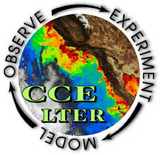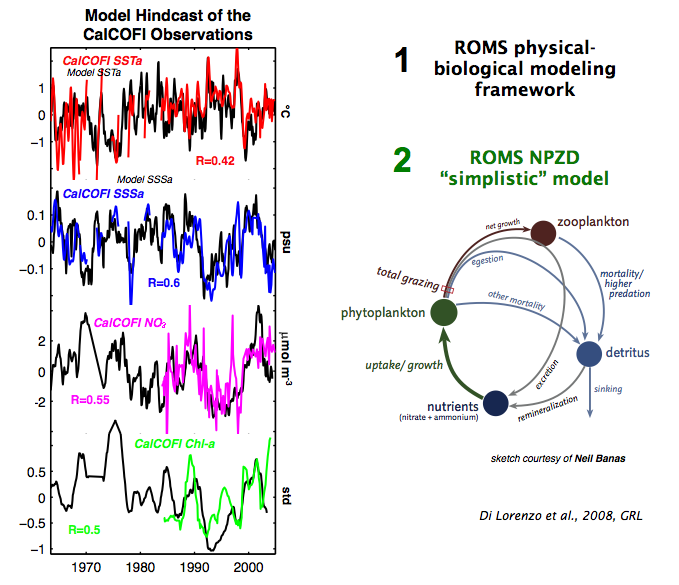Access model data through OpenDAP server - [
click here
]

Please reference this article if you use the
data:
Di Lorenzo
E., Schneider N., Cobb K. M., Chhak, K, Franks P. J. S., Miller A.
J., McWilliams J. C., Bograd S. J., Arango H., Curchister E., Powell T.
M. and P. Rivere, 2008: North Pacific Gyre Oscillation links ocean
climate and ecosystem change. Geophys. Res. Lett., 35, L08607,
doi:10.1029/2007GL032838 [
PDF ] - Download
NPGO Index
-
Background
The dynamics underlying long-term variability in the California Current are investigated with a high-resolution physical-biological model of the Northeast Pacific Ocean - the Regional Ocean Modeling System (ROMS). The model shows high skill in reproducing the physical-biological variability in the CalCOFI and Line P data. The output data of the model hindcast simulation 1950-2004 is freely available on the OpenDAP server as part of the California Current Ecosystems - Long Term Ecological Research Site (CCE-LTER)

ROMS model configuration
The Regional Ocean Modeling System (ROMS) [Shchepetkin and McWilliams, 2005] is used in a nested configuration representing the Northeast Pacific (180°W-110°W; 25°N-62°N). The model grid has 15 km average horizontal resolution and 30 vertical terrain-following layers. The model is forced with surface wind stresses and heat fluxes from the US National Centers for Environmental Prediction (NCEP) [Kalnay et al., 1996] over the period 1950-2004. The SST boundary condition includes a time-dependent relaxation to SST reanalysis [Smith and Reynolds, 2004] with a timescale H 1 month to account for errors in the NCEP surface heat fluxes [Josey et al., 2001]. The SSS boundary condition is a corrected monthly climatology of freshwater flux, which ensures that changes in salinity on periodicities larger than the seasonal cycle are only controlled by changes in ocean advection. Chl-a and NO3 are modeled with a simple nutrient-phytoplankton-zooplankton-detritus (NPZD) ecosystem model [Powell et al., 2006].
This work is sponsored by the
National Science Foundation,US GLOBEC Program and NASA MAP Program
through the Physical and Biological Oceanography programs

